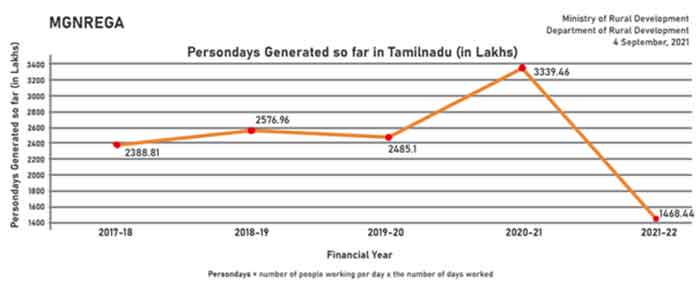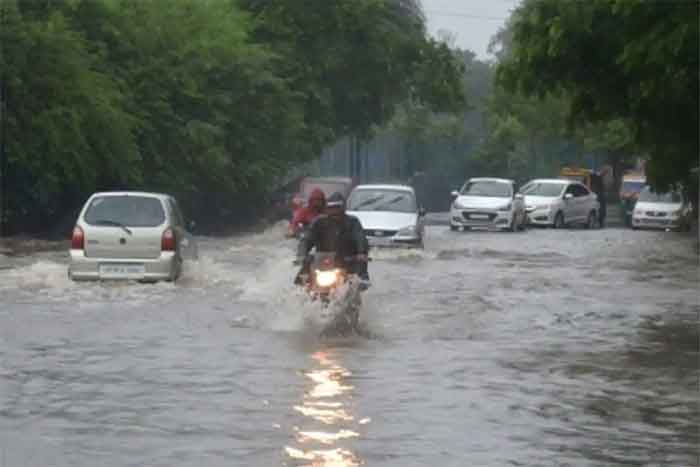T Venkat and Mathivanan
Series introduction:
For the past year and half, the Mahatma Gandhi National Rural Employment Guarantee Scheme, or colloquially called the ‘100 days employment scheme’ has been in great demand in rural Tamil Nadu. While it had already proved its value as an anti-poverty measure across rural India, its popularity has only multiplied during the economic depression that followed the Covid lockdowns.
In this two part series for Covid Response Watch T. Venkat and Mathivanan examine the benefits and pitfalls of the scheme, that needs to be expanded and strengthened across the entire country in this period of great economic distress for both the rural and urban poor.
PART ONE
With wage work becoming scarce in the rural areas, and many returning without work in cities, the ‘100 days scheme’ has become the primary source of income for many households in Tamil Nadu. Even though the income from this work was limited, it had helped some to stave off hunger and others to escape the clutches of money lenders.
“We were having great difficulty with money lenders who were demanding at least part payment. Neither my husband nor I could go to any work. We have been able to satisfy the money lenders only by paying them from the wages we got from MGNREGS work” says Nagamma. Her husband and she had got three weeks of work last year under the scheme.
MGNREGS was devised during the early years of the United Progressive Alliance 1 government from 2004-2009. The scheme became operational across India by 2008. It was to provide 100 days of ‘guaranteed’ employment to a rural household for minimum wages. Even though it had come for criticism by BJP during the UPA rule, the Modi government had to expand the scheme due to its popularity.
Poongudi, 37 years from Ramayanpatti near Madurai, had got 95 days of work last fiscal from MGNREGS.
“I lost my company work. I was in a tailoring company. I had to rely entirely on the 100 days work scheme. They paid around Rs 170-180. I used to get Rs 200 per day in the company. This work helped make some money but we still ended up having to take a loan to pay for my children’s education expense.”
 Because she couldn’t pay the book fees her younger son has not received any books. Her elder daughter had to move from a private to a government school to continue her studies. As all schools have been shut, she has to leave them home when she has to go to work.
Because she couldn’t pay the book fees her younger son has not received any books. Her elder daughter had to move from a private to a government school to continue her studies. As all schools have been shut, she has to leave them home when she has to go to work.
However, not all the guarantees provided in the MGNREGS, have been kept in full measure. In other words, the scheme has not been utilised to its full potential and to many of its beneficiaries it has been like a ‘leaky lifeboat’ – that does not let you drown but not entirely above water either
“We could have been given more work, they only gave us 6 days of work for two months. But it was very helpful to buy medicines and provisions” says Sheela, 47, a resident of a resettlement colony on the outskirts of Chennai. Her neighbour, Palaniammal, aged 62, laments that she did not even get this work because she was old and they did not let her work.
While it clearly has been a successful social security measure, it has been severely criticised for the poor infrastructure and corruption involved in implementation.
Currently, when a Gram Panchayat decides to execute a project under the scheme, they go to a centralised website to fill up the particulars of the project. The district, state ministry and the central ministry, clear the project for execution. Once the work is completed, the overseer with the district administration has to assess the work done. On his/her assessment, the wage for each worker is collectively decided. This is then transferred to the worker’s bank account within 15 days.
Discussion with the workers, activists and panchayat leaders, while exposing the bureaucratic mismanagement, also provides a policy framework that could vastly curb corruption and improve the reach and sustainability of MGNREGS.
‘Right to Work’ during forced lockdowns
The first national lock down in March 2020 was sudden. In a single late night announcement, millions were rendered jobless, denied a means to earn a living at a time when it was critical to stay nourished. The scenes of migrant workers walking back home epitomized the misery and harshness of an unplanned lockdown.
Denied the right to work, the workers turned to the Job guarantee scheme to eke out an income. This is visible in the national data on MGNREGS as well as the many anecdotal references from other states.

The data from the national portal of MGNREGS indicates the person days increased by nearly 50% in 2020-21 and over 156 crore person days of work had already been generated in four months of fiscal year 2021-22, clearly revealing the surging demand for work under this scheme across India.
Even in Tamil Nadu, work generated grew from 25 lakh person days to 33 lakh person days, an increase of 35% between 2019-20 and 2020-21. The average daily wage has also improved from around Rs 175 to Rs 200. However the daily wage is lower than the mandated minimum daily wage of Rs 273. This disparity is due to the government adopting a pay rate based on the volume of work completed instead of an hourly rate.
The government of Tamil Nadu adopted the ‘volume of work’ based wage rate for MGNREGS since 2008. Here the daily wage for the workers is paid on the basis of the work they have completed in the day rather than on the hours they were engaged. In order to make the wage assessment, the State Government, releases a ‘Schedule of Rates’ that determines the quantum of work to be carried out in an 8 hour work day.
The site supervisor, who is employed under NREGS and the overseer, who is a full time employee in the revenue or the rural development department, have to assess the work done and determine the wage. But activists claim that given the lack of qualified staff on the ground, these assessments are arbitrary and often determined by the total sum allocated for the project and the number of workers employed, rather than the actual amount of work undertaken. This, they claim is the reason for the shortfall between the real wage and the mandated wage.
The average days of work generated per household was just above 50 days in fiscal year 2020-21. While this is a significant 7 day increase over the 2019-20 figures, it is still well below the guaranteed 100 days per household. This is also not evenly spread, with some regions getting more work than others.
Amirthalingam, State General Secretary of All India Agricultural Workers Union (AIAWU), is based out of Nagapattinam and closely monitors MGNREGS work. He is positive that the scheme vastly helped rural incomes during the lockdown but says the coastal regions got a higher share of work than the inland regions due to the nature of work that is prioritized under the scheme.
“According to the Act, the villages can decide a certain work to be undertaken under MGNREGS. But in practice the state governments decide the types of work they want to fund through MGNREGS” he adds, citing as reason for regional imbalances.
It is not surprising that the workers are demanding a larger share of the work given that it has become an economic backstop for them. Their biggest complaint about the programme was that work was withheld for the older job card holders.
“I think even those about 50 years should have been given work. In fact they are the ones in most need of money during the Covid period with their children unable to take care of them financially” says Ms. Veni, who organizes women workers in Penn Thozhilalar Sangam. Palaniammal, too felt that the work has to be all year round and it should be expanded to include all people in the village. They come from rural areas, that are close to Chennai with little farm related work.
Muthu Rakku, another NREGS worker and a organizer in All India Agricultural and Rural Labour Association (AIARLA) also complained that the work under NREGS was stopped during the lockdown. “During the first lock down, one of the workers contracted Covid and died. So they stopped all work in our panchayat for many weeks. It was difficult for us” she said.
“We got about a week’s work in two to three months. . If there were holidays in that week, we end up having even less days of work” said Madhavi, an NREGS worker from Perundotham Srikazhi. “Our village is big, so it is divided into various areas. We work in groups of 15-20 per panchayat ward. Work is allocated on a rotation basis to each ward. So we get work only once in 3 months” she added.
Both Madhavi and Muthurakku, maintain that there was a need to raise the wages and pay the full daily wage. “Through AIARLA we are demanding that the wages be raised to Rs 500 a day and there is at least 300 days of guaranteed employment every year” they said.
The recently elected DMK government in Tamil Nadu, has proposed to the union government that the number of days of employment be raised to 150 from the current 100. It has even allocated more funds to support the infrastructure side of the scheme. But the state has consistently failed to even provide 50 days of annual work.
Given the numerous pitfalls, unmet targets, red tape and corruption, what are the policy options before the government and the people to make MGNREGS, a sustainable scheme for providing social security and improving rural productivity?
T Venkat is a volunteer journalist with Thozhilalar Koodam; Mathivanan is the State Committee Member of CPIML (Liberation)














































